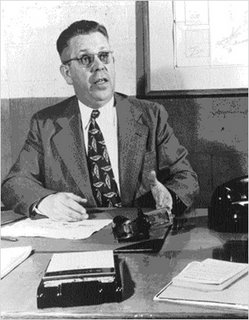


|

|
|
|
Home |
The Mil & Aero Blog
 Posted by John Keller It all began with a melted candy bar. Noted Raytheon Co. engineer Dr. Percy Spencer in 1945 was doing some research into the new technology of radio direction and ranging -- better known as radar -- at a company lab in Waltham, Mass. As he tested a new vacuum tube called a magnetron, he noticed that a candy bar he had in his pocket had melted. Following a hunch, he applied energy from the magnetron to popcorn, and later to an egg (the popcorn popped, the egg exploded). He realized that this new device heated food from the inside, and the microwave oven was born (remember the Radarange?). Radar technology was the genesis of a household appliance so common that today it outsells gas ranges. We don't use them to melt candy bars anymore, but who could be without one to defrost a pound hamburger and heat up that tepid cup of coffee? Today microwave technology is being used to develop so-called "non-lethal" weapons popularly known as the "pain ray," which can heat a person's skin to uncomfortable levels, but cause no lasting harm. This kind of weapon likely to be used for crowd control, driving off intruders, and similar applications. Dr. Spencer's discovery of how to harness microwaves for heating isn't stopping there, however. Now scientists are considering ways to use that same radar technology to comfortably warm people in their homes during cold weather, reports David Hambling in Wired's Danger Room blog. Says Hambling in his story headlined Pain Beam: Central Heating Of The Future: The temperature may be below zero, but you're not about to adjust the thermostat. Even in a light shirt, you're warm and comfortable – even if your breath does form an icy plume. Why? 'Cause you've got the energy-efficient heating system of the future: millimeter waves from your domestic Active Denial system -- or, as we've come to call it, the pain ray ... microwave heating systems could cut household heating bills by 75 per cent. And since microwaves cause light bulbs to fluoresce, such a heating system could also double as the power supply for a system of wireless lights. Such a system is far from practical use, however. As Hambling's story points out, people are generally very cautions about microwave energy, and might be hesitant to turn their homes into giant low-power microwave ovens. I can just hear a kid up in his bedroom shouting, "I'm cold; turn up the nuker!" Watch out. If mom or dad turns it up too high it just might melt the candy bar in his pocket. I live in New Hampshire where the winters can get really cold. I'm not sure if this approach could prevent pipes from freezing, and I don't know about the effect of cold on those widescreen LCD flat-panel TVs and small appliances like iPods. Yet stranger things have happened, and adventurous scientists should continue looking into this approach. At one time we never thought that radar would power our ovens, any more than we believe now that our microwave ovens could ever heat our homes. 0 Comments:
<< Home |
Welcome to the lighter side of Military & Aerospace Electronics. This is where our staff recount tales of the strange, the weird, and the otherwise offbeat. We could put news here, but we have the rest of our Website for that. Enjoy our scribblings, and feel free to add your own opinions. You might also get to know us in the process. Proceed at your own risk. 
John Keller is editor-in-chief of Military & Aerospace Electronics magazine, which provides extensive coverage and analysis of enabling electronic and optoelectronic technologies in military, space, and commercial aviation applications. A member of the Military & Aerospace Electronics staff since the magazine's founding in 1989, Mr. Keller took over as chief editor in 1995.  Courtney E. Howard is senior editor of Military & Aerospace Electronics magazine. She is responsible for writing news stories and feature articles for the print publication, as well as composing daily news for the magazine's Website and assembling the weekly electronic newsletter. Her features have appeared in such high-tech trade publications as Military & Aerospace Electronics, Computer Graphics World, Electronic Publishing, Small Times, and The Audio Amateur.
Courtney E. Howard is senior editor of Military & Aerospace Electronics magazine. She is responsible for writing news stories and feature articles for the print publication, as well as composing daily news for the magazine's Website and assembling the weekly electronic newsletter. Her features have appeared in such high-tech trade publications as Military & Aerospace Electronics, Computer Graphics World, Electronic Publishing, Small Times, and The Audio Amateur.
 John McHale is executive editor of Military & Aerospace Electronics magazine, where he has been covering the defense Industry for more than dozen years. During that time he also led PennWell's launches of magazines and shows on homeland security and a defense publication and website in Europe. Mr. McHale has served as chairman of the Military & Aerospace Electronics Forum and its Advisory Council since 2004. He lives in Boston with his golf clubs.
John McHale is executive editor of Military & Aerospace Electronics magazine, where he has been covering the defense Industry for more than dozen years. During that time he also led PennWell's launches of magazines and shows on homeland security and a defense publication and website in Europe. Mr. McHale has served as chairman of the Military & Aerospace Electronics Forum and its Advisory Council since 2004. He lives in Boston with his golf clubs.
Previous Posts
Archives
|
|||||
|
THE MAE WEBSITE AUTHORS ARE SOLELY RESPONSIBLE FOR THE CONTENT AND ACCURACY OF THEIR BLOGS, INCLUDING ANY OPINIONS THEY EXPRESS, AND PENNWELL IS NOT RESPONSIBLE FOR AND HEREBY DISCLAIMS ANY AND ALL LIABILITY FOR THE CONTENT, ITS ACCURACY, AND OPINIONS THAT MAY BE CONTAINED HEREIN. THE CONTENT ON THE MAE WEBSITE MAY BE DATED AND PENNWELL IS UNDER NO OBLIGATION TO PROVIDE UPDATES TO THE INFORMATION INCLUDED HEREIN.
|
||||||
|
|
Home | About Us | Contact Us | Corporate Website | Privacy Policy | Courage and Valor Foundation | Site Map
Also Visit: Laser Focus World | Vision Systems Design | Industrial Laser Solutions Copyright © 2007: PennWell Corporation, Tulsa, OK; All Rights Reserved. | Terms & Conditions | Webmaster |